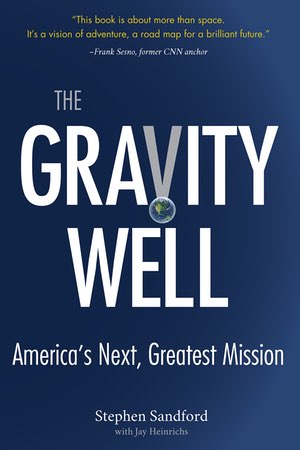Review: The Gravity Wellby Jeff Foust
|
| The book’s guiding metaphor is its title: the gravity well we are at the bottom of on Earth, but which, by climbing out, gives us access to the solar system and its resources. |
Bigelow is not the only person calling for a significant increase in NASA funding. In The Gravity Well, former NASA engineer Stephen Sandford tried to make the case for an expanded, and more expensive, space program that includes human missions to the Moon and Mars that provide benefits to life on Earth. But like Bigelow’s talk, a number of key details are missing that make the argument less persuasive.
The book’s guiding metaphor is its title: the gravity well we are at the bottom of on Earth, but which, by climbing out, gives us access to the solar system and its resources. Much of the book discusses only in general terms the benefits of space exploration: invigorating the economy; encouraging students to pursue science, technology, engineering, and mathematics (STEM) careers; and making the United States a nation others respect and want to work with.
Sandford offers a general timeline for the future of NASA in his vision: a “small working colony” on the Moon by 2030, around the same time spacecraft are mining asteroids; a colony on Mars by 2040; and “probes on other, more habitable celestial bodies, more new worlds” by 2050. But while Sandford likely has ideas of how to achieve those goals—he worked on space exploration architectures while at NASA, including a plan he briefly discusses in the book about a habitat at an Earth-Moon Lagrange point that the agency ultimately rejected in favor of the Asteroid Redirect Mission—he doesn’t go into details about how to achieve those goals in the book.
He does, though, have an idea of what it will take financially to do so. “If I were king,” he writes, “I would increase the overall NASA budget by about $1.2 billion each year for eight years and then sustain that level of investment.” That would increase NASA’s annual budget to about $30 billion (assuming unstated adjustments for inflation); much less than what Bigelow is seeking but still far more than what the agency gets today.
| The arguments presented in The Gravity Well likely will be familiar, and appeal to, space advocates who have made similar vague arguments for increasing NASA spending for the general benefit of the nation: chicken soup for the space exploration activist’s soul. |
But while it’s good to be the king, we still live in a representative democracy. Sandford tries to argue that the country can afford this more expensive space program. On one level, there is no doubt of that: $30 billion is still a small fraction of the overall federal budget. But there are many other stakeholders who also seek expanded budgets and make cases for how that additional money can help the nation. Just because you can afford one particular item at a store, based solely on its price tag and your bank balance, doesn’t mean you’ll buy it, based on your level of interest and competing priorities. Likewise, people on both ends of Pennsylvania Avenue and elsewhere would likely want more information than presented here before agreeing to any budget increase, let alone a multi-year, sustained increase. For example, what is so special about $30 billion a year? Why not $25 billion, or $35 billion?
The arguments presented in The Gravity Well likely will be familiar, and appeal to, space advocates who have made similar vague arguments for increasing NASA spending for the general benefit of the nation: chicken soup for the space exploration activist’s soul, so to speak. In any case, despite the book’s arguments and Bigelow’s plea in his speech last month, there’s so far no evidence that the incoming Trump Administration has any interest in giving NASA a big budget increase. In fact, with pressures from elsewhere in the budget, like infrastructure initiatives and defense, discretionary spending could be squeezed. The Earth’s gravity well may be steep, but the federal government’s fiscal well may be even steeper.
